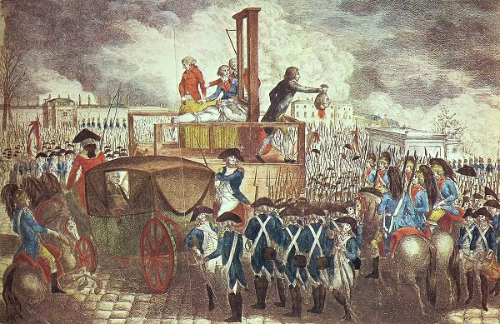
The French Revolution was a bourgeois revolution that overthrew the French monarchy. It began with the Storming of the Bastille in 1789 and ended with the Napoleonic Wars.
Constitutional monarchy
Starting in March 1789, the Estates-General met for the first time since 1614. It consisted of three estates: the clergy, the nobility, and everyone else. The Third Estate represented the common people but was dominated by lawyers and the petty bourgeoisie. When the Estates-General failed to negotiate, the Third Estate formed a National Assembly. They divided into a constitutional monarchist faction led by Marquis de Lafayette and the radical Jacobins led by Maximilien Robespierre.
On 14 July 1789, the people of Paris gathered around the Bastille, a fortress and state prison, and demanded its surrender. The guards refused and fired on the crowd, killing 83, but the revolutionaries eventually got in. The National Assembly immediately abolished feudalism, passed the Declaration of the Rights of Man, and created a National Guard. Hundreds of thousands of peasants rose up in the countryside and burned feudal land deeds. In October 1789, King Louis Capet returned to Paris under popular surveillance, establishing a constitutional monarchy. He attempted to flee to another country in July 1791 but was captured. Lafayette's forces fired on a group of republicans in Paris the next month.[1]
First Republic
In August 1792, tens of thousands of proletarians and soldiers attacked the King's house in Paris. The National Guard sided with the revolutionaries, but Swiss mercenaries attempted a counterrevolution. The revolutionaries abolished property requirements on voting and allowed all adult men to vote. A National Convention dominated by republicans met to declare a republic, and they tried and executed the King in January 1793.
The revolutionary government faced internal and external opposition, with Britain attacking France in the spring of 1793. The bourgeois Girondin faction attempted to defend private property, and some of them defected to the enemy. In May, Robespierre encouraged the people to revolt again, and mass demonstrations caused the arrest of 26 Girondin leaders. The National Convention, now controlled by Jacobins, elected a 12-member Committee of Public Safety to rule and put down counterrevolution. They executed several thousand monarchists, which was less than the number of republicans that counterrevolutionaries killed.[1]
References
- ↑ 1.0 1.1 Neil Faulkner (2013). A Marxist History of the World: From Neanderthals to Neoliberals: 'The Second Wave of Bourgeois Revolutions' (pp. 124–128). [PDF] Pluto Press. ISBN 9781849648639 [LG]